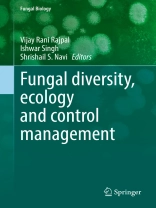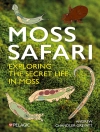This edited volume provides comprehensive and latest information on the fungal biodiversity in its morphological characters, bioactive molecules, pathogenicity and virulence, and its impacts on crop production and sustainable management of agricultural productivity towards resolving global food security issues. The increasing number of infectious fungal diseases are regarded as threats to agricultural productivity and global food security. The efforts done by scientists to inventories the fungal diversity and identification of fungal species contributing as pathogens towards many plant and human diseases have been compiled in the present volume. The identification of the potential fungal pathogens is a prerequisite for an effective disease control management program. Also important is to understand the complex interactions between the host-pathogen and the environment. The book dwells on insights on the aforementioned aspects. The book also includes articles onecological significance of fungi and fungal antagonists used as biocontrol agents on other pathogens. This compilation is useful to scientists working in similar areas as well as to undergraduate and graduate students keen on getting updated information on the subject. Scientists involved in agricultural research, crop management, and industries that manufacture agrochemicals may also find it useful read.
Cuprins
Chapter 1. Biology and management of spot blotch pathogen Bipolaris sorokiniana of wheat.- Chapter 2. Biology and Management of Ustilaginoidea virens Causing False Smut Disease of Rice (Oryza sativa L.).- Chapter 3. Diversity of Some of the Major Fungal Pathogens of Soybean and Potential Management Options.- Chapter 4. Fungi and Mycotoxin in Rice: Concerns, Causes and Prevention Strategies.- Chapter 5. Bioactive profile of the wild mushroom Trogia cantharelloides.- Chapter 6. Prospects of Cordycepin and Polysaccharides produced by Cordyceps.- Chapter 7. Genome-mediated methods to unravel the native biogeographical diversity and biosynthetic potential of Trichoderma for plant health.- Chapter 8. The Diversity and Taxonomy of Phytopathogenic fungi in the genus Cladosporium from India.- Chapter 10. Diversity of Corticioid Fungi Belonging to the Family Meruliaceae in Chamba District of Himachal Pradesh.- Chapter 11. Diversity of Some Colorful Poroid and Non-poroid Agaricomyceteous Fungi and their Economic Importance.- Chapter 12. The Ganoderma: Biodiversity and Significance.- Chapter 13. Exploring Marine Fungal Diversity and their Applications in Agriculture.- Chapter 14. Arbuscular Mycorrhizal (AM) Fungal Diversity from Coastal Dunes.- Chapter 15. Facets of AM Fungi in Sequestering Soil Carbon and Improving Soil Health.- Chapter 16. Arbuscular Mycorrhizal Fungi Influence Crop Productivity, Plant Diversity and Ecosystem Services.- Chapter 17. Mycoremediation: A Natural Solution for Unnatural Problems.- Chapter 18. Fungal mediated effective exploitation of uncongenial wastes from environment.- Chapter 19. Impact of Fungi on Agriculture Production, Productivity and Sustainability.- Chapter 20. Efficacy of seed treatments with Bradyrhizobium japonicum to reduce occurrence of soybean sudden death syndrome in early-planted soybeans.- Chapter 21. Biocontrol potential of Bradyrhizobium japonicum against soybean sudden death syndrome – in irrigated and non-irrigatedfields.- Chapter 22. Fungal Biocontrol Agents- An Eco-friendly Option for the Management of Plant Diseases to Attain Sustainable Agriculture in India.- Chapter 23. Challenges and Threats Posed by Plant Pathogenic Fungi on Agricultural Productivity and Economy.- Chapter 24. Challenges Faced by Farmers in Crops Production due to Fungal Pathogens and their Effect on Indian Economy.- Chapter 25. Understanding the Various Strategies for the Management of Fungal Pathogens in Crop Plants in the Current Scenario.- Chapter 26. Molecular basis of host-pathogen interaction: An overview.- Chapter 27. Biocontrol potential of fungi for pest and pathogen management.- Chapter 28. Role of Fungal Biocontrol Agents for Sustainable Agriculture.- Chapter 29. Antagonistic Fungi against Plant Pathogens for Sustainable Agriculture.
Despre autor
Dr. Vijay Rani Rajpal is a professor in the Botany Department, Hansraj College, Delhi University, Delhi, India, and has approximately 25 years of research experience in working on population biology, phylogenetics, and diversity of plants. She has 45 published research papers, review articles, and book chapters and has edited 4 books on molecular diversity, abiotic stress mitigation, and improvement of plants published by Springer Switzerland. She has guided Ph.D. students and successfully completed a number of research projects funded by various agencies of the Government of India. She is a reviewer of several reputed national and international research journals and invited guest editor for a thematic issue of Frontiers in Genetics.
Dr. Ishwar Singh, a trained mycologist, has been researching in the field of microbiology with special focus on mycotoxins and characterization of phytopathogens and their biocontrol for the last 20 years. He was a visiting faculty in the Department of Plant Pathology and microbiology, Iowa State University of Science and Technology, Ames, Iowa, USA (2014–15, Raman Research Fellowship). He has also been a recipient of UGC Research Award (2013). Currently, he is working as an associate professor in the Department of Botany at Hansraj College, University of Delhi, Delhi, India. He has published 30 research papers and articles and successfully completed a number of research projects. He is a member of the editorial board of many journals.
Dr. Shrishail S. Navi works in the Department of Plant Pathology and Microbiology, and the Department of Entomology, Iowa State University (ISU), as research scientist III. His focus is on managing major soilborne pathogens of soybean, corn, field pea, and spinach. His research is supported by industry dollars (Avg. $88K/year). He has published books, bulletins, and book chapters (16); journal articles on soybean (27), sorghum (29), pearl millet (16), and wheat (15); and extension articles on soybean (35). He is a fellow of Indian Phytopathological Society, link scientist of CAB International, editor of Indian Phytopathology (2015–2020), and reviewer of several national and international journals. Prior to joining ISU in 2003, he worked at the ICRISAT for 14 years.












